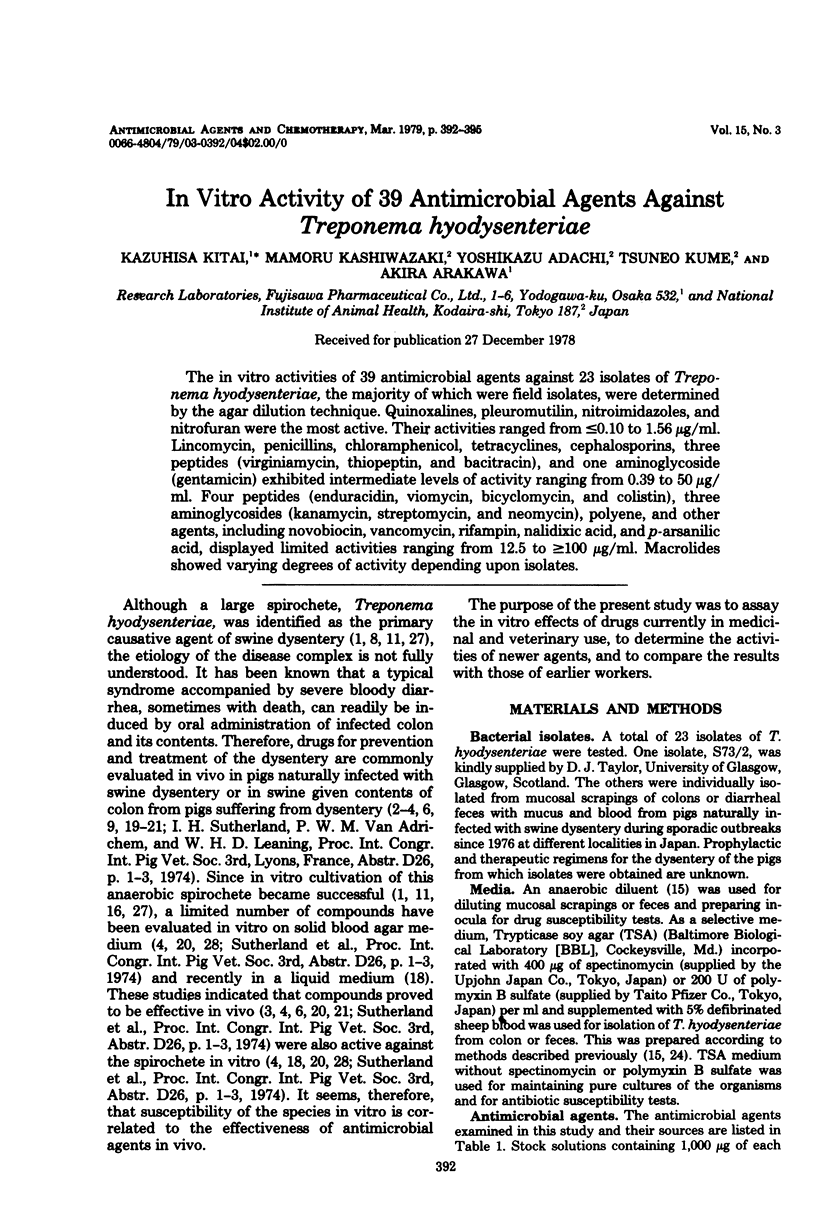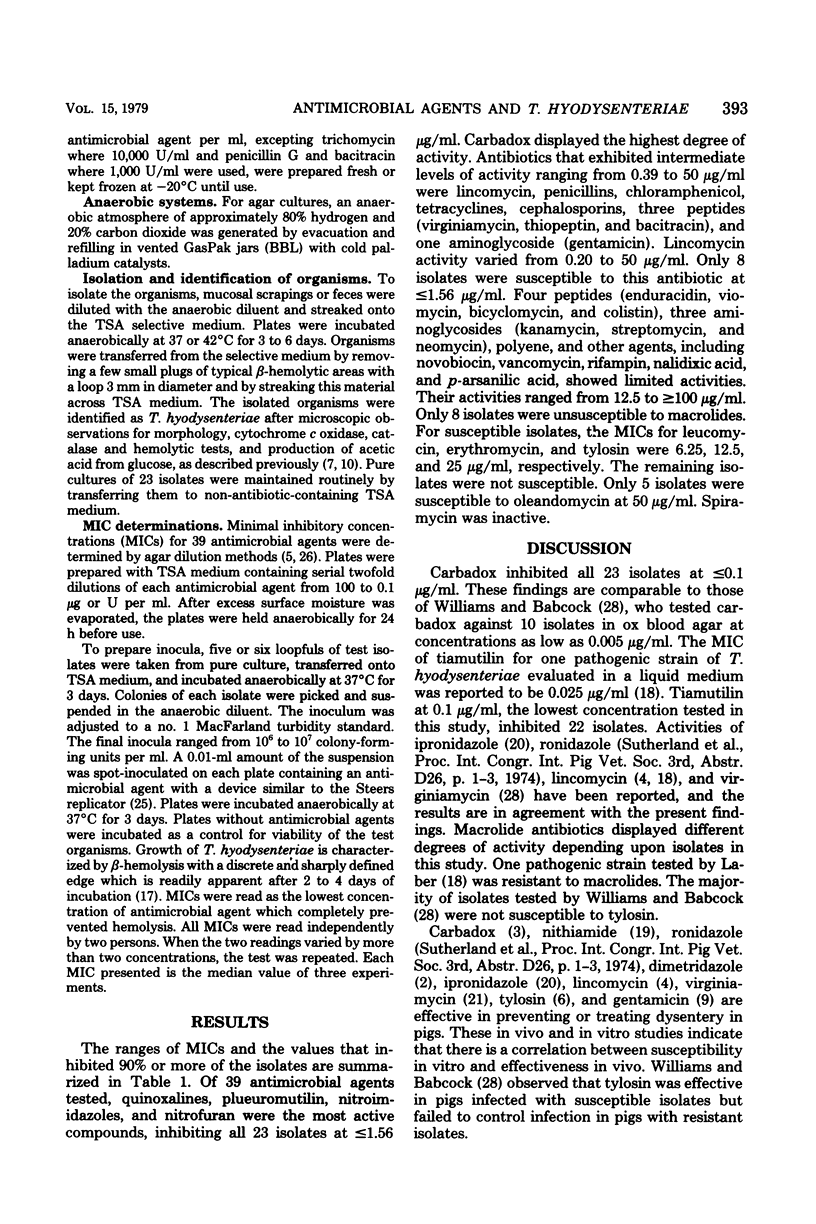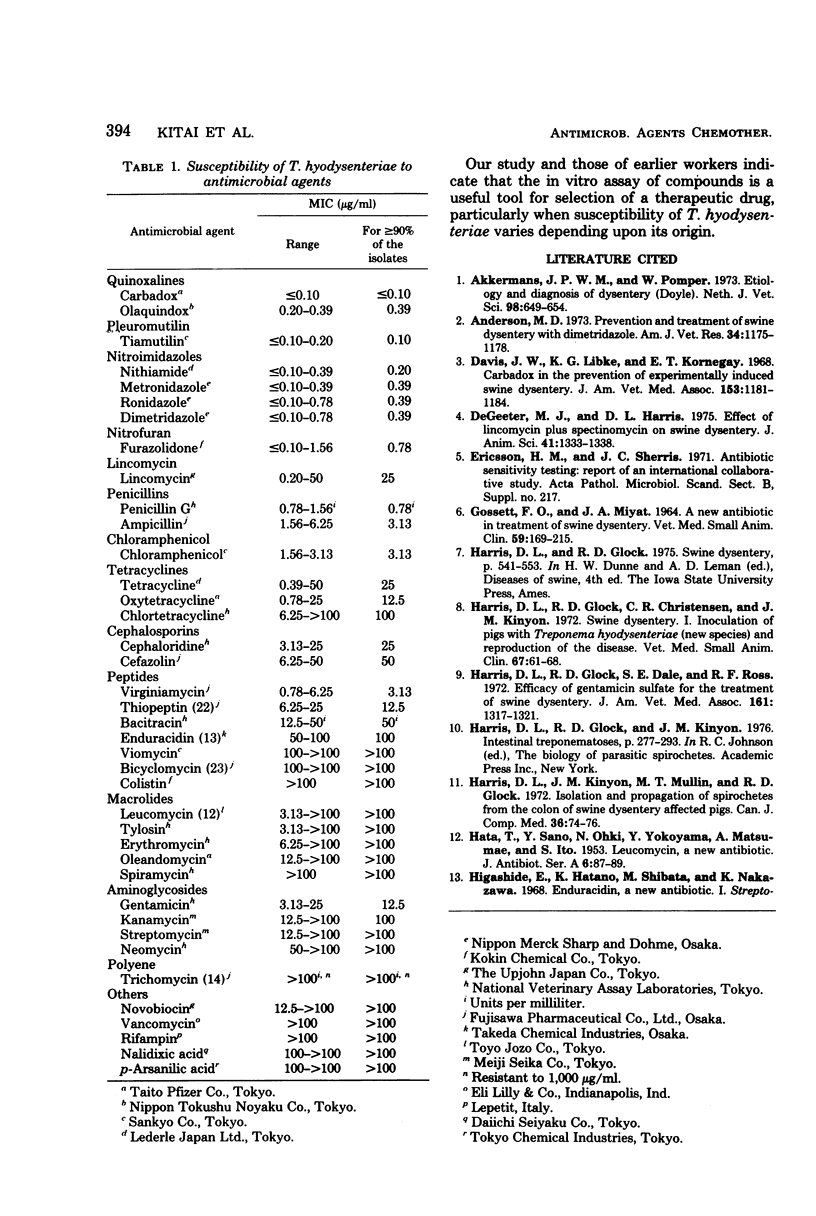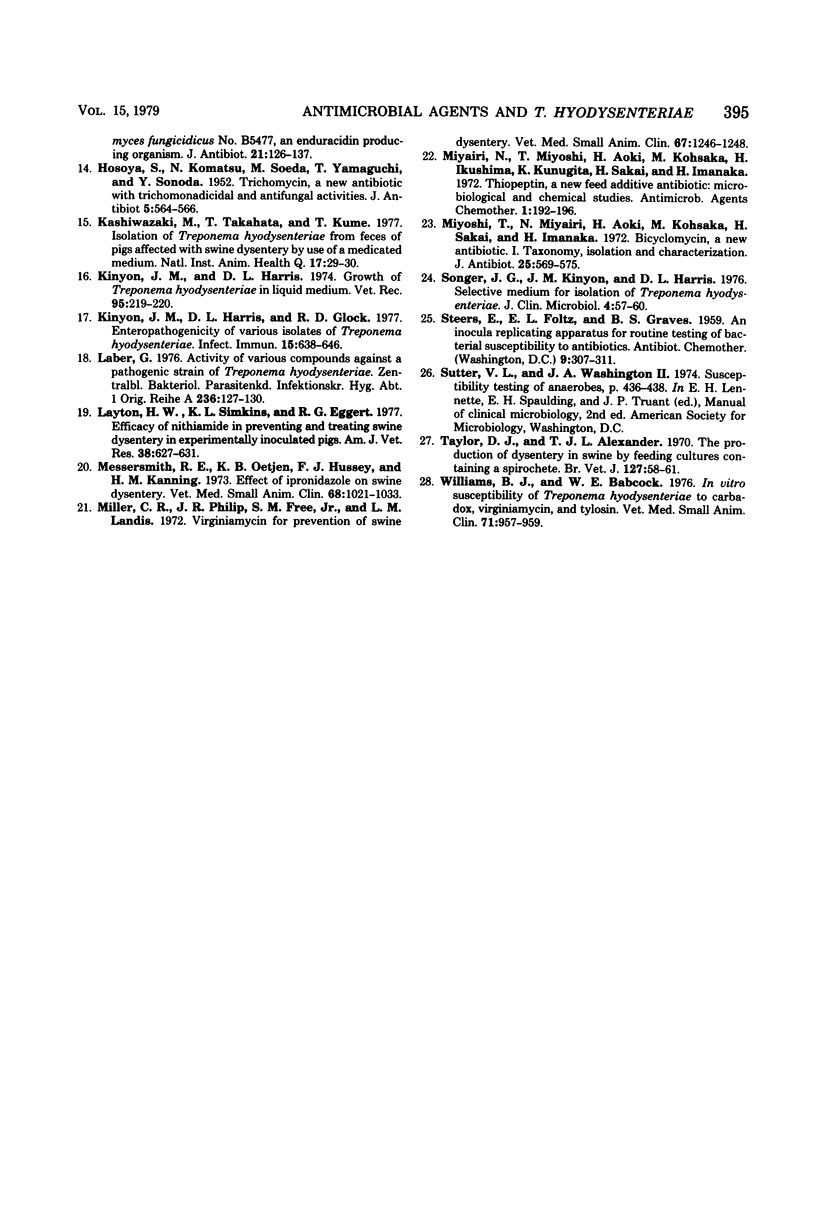Abstract
The in vitro activities of 39 antimicrobial agents against 23 isolates of Treponema hyodysenteriae, the majority of which were field isolates, were determined by the agar dilution technique. Quinoxalines, pleuromutilin, nitroimidazoles, and nitrofuran were the most active. Their activities ranged from ≤0.10 to 1.56 μg/ml. Lincomycin, penicillins, chloramphenicol, tetracyclines, cephalosporins, three peptides (virginiamycin, thiopeptin, and bacitracin), and one aminoglycoside (gentamicin) exhibited intermediate levels of activity ranging from 0.39 to 50 μg/ml. Four peptides (enduracidin, viomycin, bicyclomycin, and colistin), three aminoglycosides (kanamycin, streptomycin, and neomycin), polyene, and other agents, including novobiocin, vancomycin, rifampin, nalidixic acid, and p-arsanilic acid, displayed limited activities ranging from 12.5 to ≥100 μg/ml. Macrolides showed varying degrees of activity depending upon isolates.
Full text
PDF



Selected References
These references are in PubMed. This may not be the complete list of references from this article.
- Akkermans J. P., Pomper W. Aetiology and diagnosis of swine dysentery (Doyle). Tijdschr Diergeneeskd. 1973 Jul 15;98(14):649–654. [PubMed] [Google Scholar]
- Anderson M. D. Prevention and treatment of swine dysentery with dimetridazole. Am J Vet Res. 1973 Sep;34(9):1175–1178. [PubMed] [Google Scholar]
- Davis J. W., Libke K. G., Kornegay E. T. Carbadox in the prevention of experimentally induced swine dysentery. J Am Vet Med Assoc. 1968 Nov 1;153(9):1181–1184. [PubMed] [Google Scholar]
- DeGeeter M. J., Harris D. L. Effect of lincomycin and spectinomycin on swine dysentery. J Anim Sci. 1975 Nov;41(5):1333–1338. doi: 10.2527/jas1975.4151333x. [DOI] [PubMed] [Google Scholar]
- Ericsson H. M., Sherris J. C. Antibiotic sensitivity testing. Report of an international collaborative study. Acta Pathol Microbiol Scand B Microbiol Immunol. 1971;217(Suppl):1+–1+. [PubMed] [Google Scholar]
- HATA T., SANO Y., OHKI N., YOKOYAMA Y., MATSUMAE A., ITO S. Leucomycin, a new antibiotic. J Antibiot (Tokyo) 1953 Apr;6(2):87–89. [PubMed] [Google Scholar]
- Harris D. L., Glock R. D., Christensen C. R., Kinyon J. M. Inoculation of pigs with Treponema hyodysenteriae (new species) and reproduction f the disease. Vet Med Small Anim Clin. 1972 Jan;67(1):61–64. [PubMed] [Google Scholar]
- Harris D. L., Glock R. D., Dale S. E., Ross R. F. Efficacy of gentamicin sulfate for the treatment of swine dysentery. J Am Vet Med Assoc. 1972 Dec 1;161(11):1317–1321. [PubMed] [Google Scholar]
- Harris D. L., Kinyon J. M., Mullin M. T., Glock R. D. Isolation and propagation of spirochetes from the colon of swine dysentery affected pigs. Can J Comp Med. 1972 Jan;36(1):74–76. [PMC free article] [PubMed] [Google Scholar]
- Kashiwazaki M., Takohata T., Kume T. Isolation of Treponema hyodysenteriae from feces of pigs affected with swine dysentery by use of a medicated medium. Natl Inst Anim Health Q (Tokyo) 1977 Spring;17(1):29–30. [PubMed] [Google Scholar]
- Kinyon J. M., Harris D. L., Glock R. D. Enteropathogenicity of various isolates of Treponema hyodysenteriae. Infect Immun. 1977 Feb;15(2):638–646. doi: 10.1128/iai.15.2.638-646.1977. [DOI] [PMC free article] [PubMed] [Google Scholar]
- Kinyon J. M., Harris D. L. Growth in Treponema hyodysenteriae in liquid medium. Vet Rec. 1974 Sep 7;95(10):219–220. doi: 10.1136/vr.95.10.219. [DOI] [PubMed] [Google Scholar]
- Laber G. Activity of various compounds against a pathogenic strain of Treponema hyodysenteriae. Zentralbl Bakteriol Orig A. 1976 Oct;236(1):127–130. [PubMed] [Google Scholar]
- Layton H. W., Simkins K. L., Eggert R. G. Efficacy of nithiamide in preventing and treating swine dysentery in experimentally inoculated pigs. Am J Vet Res. 1977 May;38(5):627–631. [PubMed] [Google Scholar]
- Messersmith R. E., Oetjen K. B., Hussey F. J., Kanning H. H. Effect of ipronidazole on swine dysentery. Vet Med Small Anim Clin. 1973 Sep;68(9):1021–passim. [PubMed] [Google Scholar]
- Miller C. R., Philip J. R., Free S. M., Jr, Landis L. M. Virginiamycin for prevention of swine dysentery. Vet Med Small Anim Clin. 1972 Nov;67(11):1246–1248. [PubMed] [Google Scholar]
- Miyairi N., Miyoshi T., Aoki H., Kosaka M., Ikushima H. Thiopeptin, a new feed additive antibiotic: microbiological and chemical studies. Antimicrob Agents Chemother. 1972 Mar;1(3):192–196. doi: 10.1128/aac.1.3.192. [DOI] [PMC free article] [PubMed] [Google Scholar]
- Miyoshi T., Miyairi N., Aoki H., Kosaka M., Sakai H. Bicyclomycin, a new antibiotic. I. Taxonomy, isolation and characterization. J Antibiot (Tokyo) 1972 Oct;25(10):569–575. doi: 10.7164/antibiotics.25.569. [DOI] [PubMed] [Google Scholar]
- Songer J. G., Kinyon J. M., Harris D. L. Selective medium for isolation of Treponema hyodysenteriae. J Clin Microbiol. 1976 Jul;4(1):57–60. doi: 10.1128/jcm.4.1.57-60.1976. [DOI] [PMC free article] [PubMed] [Google Scholar]
- Taylor D. J., Alexander T. J. The production of dysentery in swine by feeding cultures containing a spirochaete. Br Vet J. 1971 Nov;127(11):58–61. doi: 10.1016/s0007-1935(17)37282-2. [DOI] [PubMed] [Google Scholar]
- Williams B. J., Babcock W. E. In vitro susceptibility of Treponema hyodysenteriae to carbadox, virginiamycin, and tylosin. Vet Med Small Anim Clin. 1976 Jul;71(7):957–959. [PubMed] [Google Scholar]


